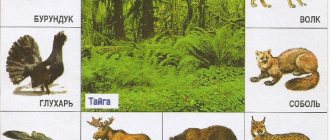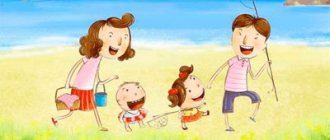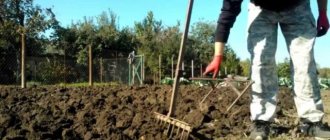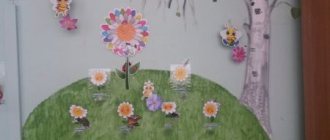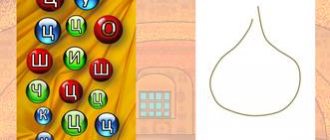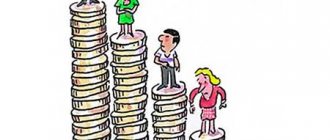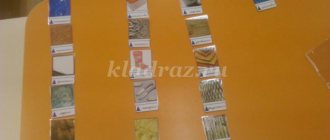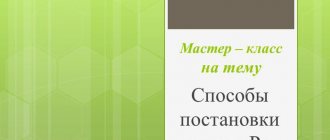GCD in the preparatory speech therapy group Topic: “Transport”
Correctional and educational goals.
- Expanding and consolidating ideas about transport based on generalization of previously formed ideas.
- Clarification, expansion and activation of the dictionary on the topic “Transport”.
- Formation of ideas about types of transport.
- Improving the grammatical structure of speech.
Correctional and developmental goals: development of visual attention and perception, speech hearing, fine and gross motor skills, creative imagination.
Educational goals: developing skills of cooperation, independence, initiative, goodwill.
Equipment: magnetic board, object pictures with images of transport, a container with pencils, a ball, a “noisy picture”, sheets of paper with images of rectangles, a reference table for composing a story.
1. Organizational moment. Game "I have...". (Agreement of nouns with numerals.)
The teacher greets the children, invites them into the office and invites them to stand near the chairs. Each child has an object picture on their chair.
Educator: Look at your pictures, count the vehicles on them. Take turns sitting down and tell them what is shown in your pictures.
1st child: I have two cars.
2nd child: I have five planes.
3rd child: I have five helicopters
4th child: I have two ships.
Educator: Well done! You did an excellent job.
2. Conversation with children about transport while looking at pictures. (Expansion and consolidation of ideas about transport based on the generalization of previously formed ideas. Consolidation of the concepts of “freight” and “passenger” transport. Formation of ideas about types of transport.)
The teacher places pictures on the magnetic board: trolleybus, bus, tram.
Educator: What kind of transport is this?
Children: Passenger transport.
Educator: What is passenger transport needed for?
Children: For transporting passengers.
The teacher places pictures on the magnetic board: truck, dump truck, van.
Educator: What kind of transport do you see?
Children: This is a freight transport.
Educator: Correct. Where does all this transport move?
Children: On the way.
Educator: And that’s why it’s called road transport.
Work is carried out similarly with air, water, rail, and underground transport.
3. Outdoor game “Motor ship” (coordination of speech with movement)
| From the green pier | Step forward, hands down |
| The ship pushed off. | |
| One, two - | Two steps back |
| He took a step back first. | |
| And then he stepped forward - | Two steps forward |
| One, two - | |
| And he swam, swam along the river, | Arms extended forward and closed - |
| Getting into full swing. | This is the bow of the ship. Movement in a circle in small steps. |
4. “Compiling stories based on individual pictures using a reference table” (Development of coherent speech.)
Educator: We named all types of transport. And now, each of you will take one picture and make up your own story and transport according to the table.
The teacher places a reference table on the board, with the help of which each child composes a story based on his individual picture.
Educator: Well done! And now I offer you a new game.
5. Game “Recognize objects” (Development of imagination, visual attention.)
Children are offered a picture depicting “noisy” objects (transport).
Children must recognize and name objects.
6. Game “Draw the rectangles to make a vehicle.” (Development of manual motor skills, visual perception, attention, imagination.)
The teacher gives the children sheets of paper on which rectangles of various sizes and simple pencils are depicted.
Educator: Look, there are drawn rectangles in front of you. Make these rectangles turn into vehicles.
Children complete tasks and then say what they did.
7. Game “What’s extra?” with a ball. (Development of speech hearing.)
The teacher invites the children to go to the carpet and play a game.
Educator: And the last task today. I list the names of the vehicles and throw the ball, and each of you, having caught the ball, determines what is unnecessary and why.
Educator: bus, car, bulldozer.
Child: An extra bulldozer, because... it refers to construction equipment, and a car and a bus are passenger transport.
A similar task is given to each child.
8. End of the lesson: (Assessment of children’s work.)
Children list the tasks they have completed and evaluate each other's work.
Summary of a speech therapy lesson with TRIZ elements on the topic “Transport” in the preparatory group
Summary of speech therapy classes in the preparatory group
with TRIZ elements on the topic: “Transport”.
Target:
consolidate and generalize children's knowledge about transport
.
Tasks:
1. Correctional - educational:
— systematization of children’s knowledge about various types of transport, its components, functions;
— activation of the dictionary on the topic;
- improving the grammatical structure of speech.
2. Corrective and developmental:
— development of coherent speech and verbal communication skills;
- development of memory, verbal-logical thinking, voluntary attention
3. Correctional and educational:
— developing cooperation skills in the classroom;
- fostering independence, activity, and a sense of collectivism.
Progress of the lesson
Speech therapist.
Guys,
how did you get
to kindergarten today? And I arrived by train. How can you call a bus, a car, an electric train in one word?
Before we talk to you about transport, let’s do some articulation exercises:
- Let's show how the steamer hums (we hold the tip of our tongue with our teeth, pronounce Y - we get the sound L);
- The wheels of the train are knocking (like the “Woodpecker” exercise, only with the rhyme of the wheels knocking);
- How the container rotates in a concrete mixer (mouth closed, run your tongue in a circle under the upper and lower lip);
- How car wipers work (like the “Clock” exercise).
Speech therapist.
What
types of transport
do you know by type of travel? Air, land, water. Look at the symbols. Why is transport called air transport? (because it flies in the air, high in the sky). Why is transport called water transport? (because it travels on water) Why is transport called land transport (because it travels on land). Let's put these symbols in the morpho table. Now take any picture from the bag and place it under the desired type of transport. Masha, what kind of transport do you have? etc.
Speech therapist.
“Yes-No”
with you What rule of this game do you know?
(
“Find the middle, remove the half”).
First, 1-2 children independently guess the objects, and the rest of the children guess.
Speech therapist.
Now I will wish for an object for you. (Children guess)
- Yes, this is a car. What other machines do you know by type of purpose? Cars, trucks, specials, passengers.
Take 2 pictures and you and I will play the game “ 1,2,3 come to me”
". 1,2,3 freight transport come to me. Denis, prove that you have a cargo transport. etc. Now insert your pictures behind any numbers. So that behind each number there is an object.
Speech therapist.
Guys, you and I know that our speech consists of sentences, sentences consist of words, and syllables consist of sounds.
What sounds do you know
? What color represents vowel sounds? What about consonants? What are the types of consonants (hard and soft)
- Artyom, choose any two numbers. What kind of transport did you get? Determine what the first sound is
in the titles of your pictures and place them in the right place in the morphotable. etc.
(under each number there is a picture with transport)
Speech therapist.
Children, how is this transport different from each other?
Let's try to describe an object using a diagram. Take toy vehicles and object description diagrams. Tell your guests about your transport
. (Each child chooses a toy, approaches any guest and talks about it according to the diagram)
Speech therapist.
Guys, look how many guests have gathered today.
What do you think is 30 guests a lot or a little, and, for example, 50 cars - a lot or a little? What about 50 hairs on your head? Let's count your transport
. I will show the numbers, and you tell me how many of your objects there will be?
Bottom line.
And now those who
give me a question
. Select any question type.
Here's the lesson with all the tables
Lesson “Transport” DOCX / 8.62 MB
/data/files/d1563093456.docx (TRIZ game “Describe the object”)
/data/files/a1563092390.docx (table)

